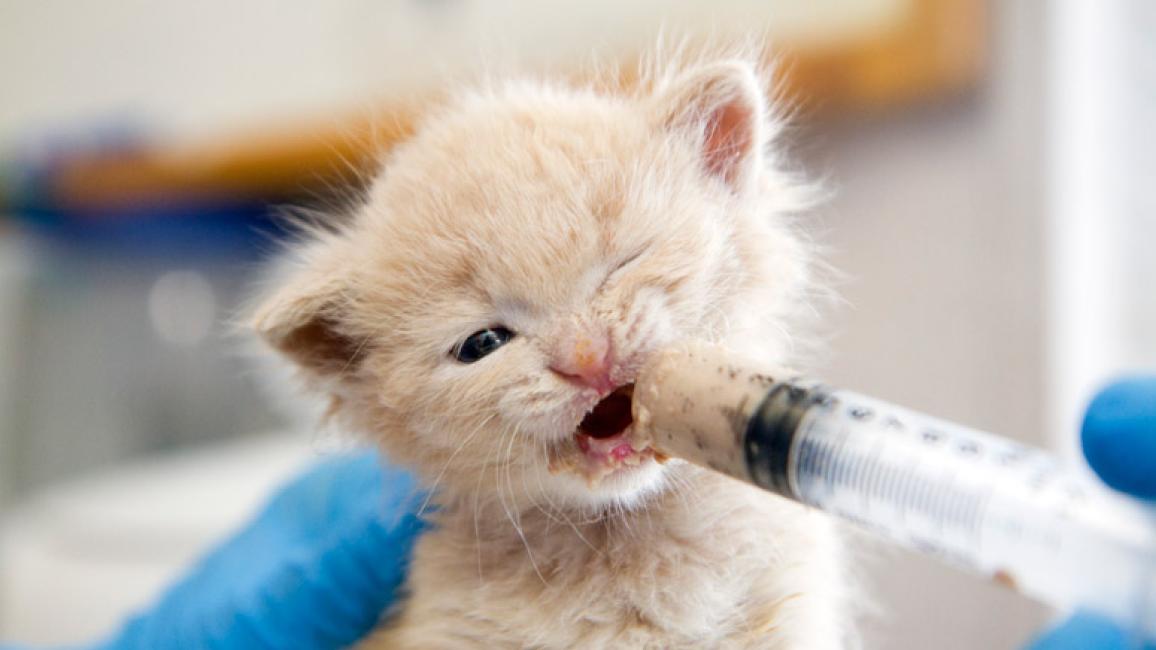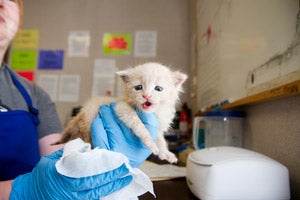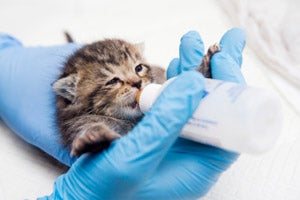Orphaned kitten care and feeding

If kittens are under four weeks old (to determine a kitten’s age, read the second article in this series), they need to be housed in a way that keeps them safe and warm, and they need to be bottle-fed until they are big enough to graduate first to gruel, then solid food. The tips here will help you set up a cozy and safe home for the kittens and will let you know what to expect in those first weeks.
Keeping kittens warm
 A dog crate or kennel is a good choice of enclosure for keeping the kittens safe and contained, as well as for monitoring the temperature. This is important because keeping kittens warm is crucial. Janice Dankert, Best Friends community cat program supervisor, explains, “When kittens are cold, their bodily functions quit working.” If any of the kittens are limp or minimally responsive, or are cool or cold to the touch, this is indicative of an emergency situation – you should provide heat to the kitten and take him or her to the vet right away.
A dog crate or kennel is a good choice of enclosure for keeping the kittens safe and contained, as well as for monitoring the temperature. This is important because keeping kittens warm is crucial. Janice Dankert, Best Friends community cat program supervisor, explains, “When kittens are cold, their bodily functions quit working.” If any of the kittens are limp or minimally responsive, or are cool or cold to the touch, this is indicative of an emergency situation – you should provide heat to the kitten and take him or her to the vet right away.
Best Friends veterinarian Dr. Patti Patterson recommends keeping the room temperature above 75 degrees or so. Kittens also need constant heat by way of a heating pad, without an automatic shutoff, set on low. Trielle Gritton, senior manager of adoptions and outreach at Best Friends Animal Society–Utah, says, “The heating pad should be covered in cloth – old towels, throws or blankets work well. And it should only cover half the enclosure so the kittens can move away from it.” An alternative to a heating pad is a microwaveable disc (called SnuggleSafe) made just for keeping pets warm.
Regular monitoring is important to ensure the kittens aren’t too hot or cold. Dr. Patti says, “If the kittens feel cold to the touch, they’re too cold. They should feel toasty warm, but if they are panting or seem to be stretched out away from each other, this may indicate too much heat – you can turn down the heating pad or open the top of the dog crate to allow the area to cool down.”
Trielle adds, “It is also very important to remember that a kitten should never be fed cold formula, and they should never be fed if they are cold.”
Feeding kittens
 “Kittens need to be bottle-fed formula until they’re about four weeks old, and then they can begin to wean,” says Trielle. If you have found the kittens after the pet supply store has closed for the day, you can use goat’s milk as a stopgap, but this should not be used for an extended period of time. Kitten formula, bottles, rubber nipples, and cleaning supplies are available at most pet supply stores, and even many grocery stores. Follow the instructions carefully on the formula package to ensure proper mixing and handling.
“Kittens need to be bottle-fed formula until they’re about four weeks old, and then they can begin to wean,” says Trielle. If you have found the kittens after the pet supply store has closed for the day, you can use goat’s milk as a stopgap, but this should not be used for an extended period of time. Kitten formula, bottles, rubber nipples, and cleaning supplies are available at most pet supply stores, and even many grocery stores. Follow the instructions carefully on the formula package to ensure proper mixing and handling.
Trielle says, “It is important to note that kittens should never be fed on their backs, but their bellies should always touch the floor (or other surface) when being bottle-fed.” Best Friends veterinarian Dr. Patti Patterson recommends allowing the kittens to eat until satiated. On average, it should take approximately 10 to 15 minutes to properly feed each kitten at every stage until weaned.
Kittens also need help eliminating (going to the bathroom) until they are about three to four weeks old. To do this, use a warm, damp washcloth to gently massage the anal area until they go. This should be done every time you feed each kitten. A litter box with only non-clumping litter can be introduced when kittens are about three weeks of age. Kittens will not have solid stool while still drinking formula.
Kitten care information
This article is the third in a four-part series on caring for baby kittens who are abandoned. Read more about orphaned kittens in part 4.
For more on feeding orphaned kittens, view this Best Friends resource.
Become a foster parent to help care for orphaned kittens in your area.
Photos by Sarah Ause Kichas